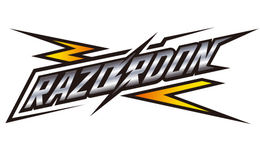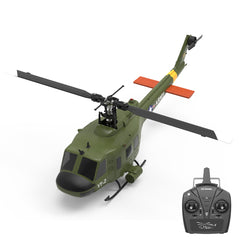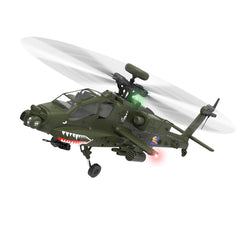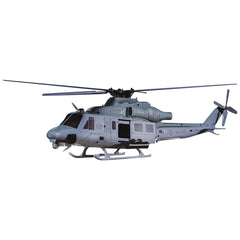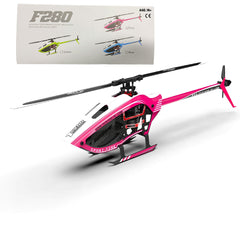
What Is 3D RC Helicopter Flying?
Defining 3D RC Helicopter Flight
How 3D Flying Mode Works

Key Characteristics of 3D Flying
- Inverted Flight: Helicopters fly upside down, requiring reversed control inputs.
- Extreme Maneuvers: Rapid flips, rolls, and hurricanes demand high skill.
- High Power-to-Weight Ratio: 3D helis use brushless motors and lightweight frames for explosive performance.
How 3D RC Helicopters Differ from Standard Models
Design and Performance Differences
| Feature | 3D RC Helicopters | Standard RC Helicopters |
| Design Focus | Engineered for agility and aerobatics | Prioritize flight stability and ease of control |
| Rotor Type | Collective pitch rotors (variable pitch) | Fixed-pitch rotors (simpler control) |
| Flight Control System | Flybarless systems for faster, more precise response | Often use flybar systems or basic stabilization |
| Frame Material | Lightweight materials for quick maneuverability | Heavier or more basic materials for durability and cost savings |
| Motor | High-torque motors for aggressive 3D performance | Standard motors for stable cruising flight |
| Flight Capabilities | Inverted flight, flips, rolls, tick-tocks, complex stunts | Upright flight, limited maneuvers |
| User Level | Intermediate to advanced pilots | Beginners to casual flyers |
Why 3D Helicopters Are Built for Aerobatics

Can Anyone Learn to Fly 3D RC Helicopters?
Who 3D Flying Is (and Isn’t) For
- Already mastered basic orientations (nose-in, side-in).
- Have quick reflexes and patience for practice.
- Can afford higher crash costs.
- Prefer relaxed, scale flying.
- Are new to RC helicopters
Skills and Reflexes Required for 3D Flight
Beginner Tips for Learning 3D RC Helicopter Skills
Why You Need a Simulator for Learning 3D
- Crash Risk Reduction – Practice without repair bills.
- Muscle Memory Development – Train your brain for inverted control reversals.
- Recommended Simulators:
- RealFlight Evolution (best for realism).
- AccuRC (budget-friendly).

The Step-by-Step 3D Flying Lesson Plan
- Master Hovering: Learn to hover in all orientations using a simulator.
- Basic Maneuvers: Practice loops and rolls in a controlled environment.
- Inverted Flight: Train for inverted hovering to understand command reversals.
- Join a Community: Engage with RC forums like RCGroups or local clubs for tips and mentorship.
Common Mistakes New Pilots Make
- Progressing too quickly
- Flying without checking the trim or gyro
- Using worn blades or loose parts
- Panic pulling the collective while inverted (causing a crash)

The most recommended 3D remote control helicopter model in 2025
- YU XIANG F07-V – Compact design with 6G/3D dual flight modes, brushless direct-drive system, and optical flow positioning for enhanced low-altitude stability.
- YU XIANG F11 AH64 Apache – Military-inspired aesthetic with dual-axis co-drive, 6G/3D switchable modes, and powerful brushless setup for precise control.
- GOOSKY E2 UH-1Y – High-performance flybarless system with GPS assistance, dual brushless motors, and advanced electronics for aggressive 3D aerobatics.
- YU XIANG F280 – Lightweight carbon-frame helicopter with 6-axis gyro, direct-drive brushless power, and seamless switching between 6G stabilization and 3D stunt mode.
Comparison: Price, Features & Flight Modes
| Model | Price Range (USD) | Key Features | Flight Modes |
| YU XIANG F07-V | $200–$300 | Brushless direct-drive, optical flow positioning, carbon frame | 6G / 3D Switchable |
| YU XIANG F11 AH64 | $350–$500 | Military-style fuselage, dual-axis co-drive, brushless motor | 6G / 3D Switchable |
| GOOSKY E2 UH-1Y | $400–$550 | Flybarless, GPS-assisted, dual brushless motors, high-performance control system | Full 3D / GPS / Stabilized |
| YU XIANG F280 | $650–$800 | 6-axis gyro, modular carbon body, direct-drive brushless power | 6G / 3D Switchable |
Common Challenges and How to Overcome Them
Understanding Cyclic and Tail Rotor Reversals
Managing Crash Risks and Cost
-
Typical Crash Repairs:
- Blades ($30–$100).
- Feathering shaft ($15).
- Servo gears ($10–$40).
Building Mental Reflexes Over Time

Safety and Maintenance Tips for 3D RC Helicopters
Pre-Flight Checks for 3D Maneuvers
- Verify Servo Movement and Response (No jitters or delayed response)
- Check Blade Mounting and Tension (not too loose/stiff)
- Inspect Linkages and Swashplate ( not cracked and stripped )
- Test Failsafe and Throttle Cut (throttle cut works)
- Battery and Voltage Readiness(No puffing, discoloration, or exposed wires)
- Rotor Head and Tail Assembly Tightness
- Make sure no people, pets, or obstacles are nearby
- Gyro and Stabilization Calibration
Battery Safety During Inverted Flights
- Use high-quality LiPo batteries.
- Monitor charge levels (Avoid discharging below 20%), and avoid over-discharging.
- Store batteries in fireproof bags to prevent hazards during charging or transport.
Common Repair Scenarios After a Crash

FAQs About 3D RC Helicopters
How Long Does It Take to Learn 3D Flying?
Can I Convert a Standard Heli to 3D?
3D Helicopters vs. FPV Drones: Which Is Harder?
Final Thoughts: Is 3D Flying Worth the Effort?

